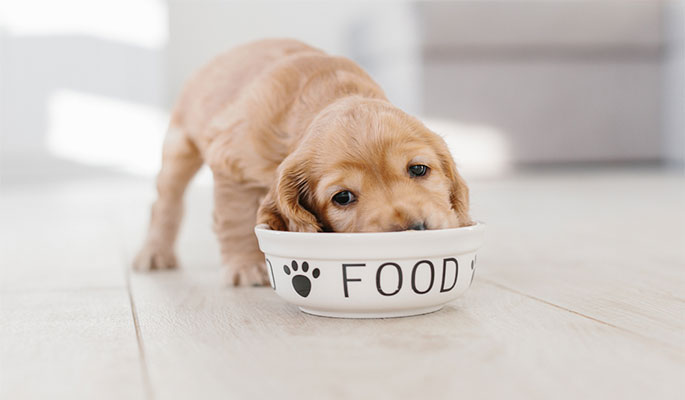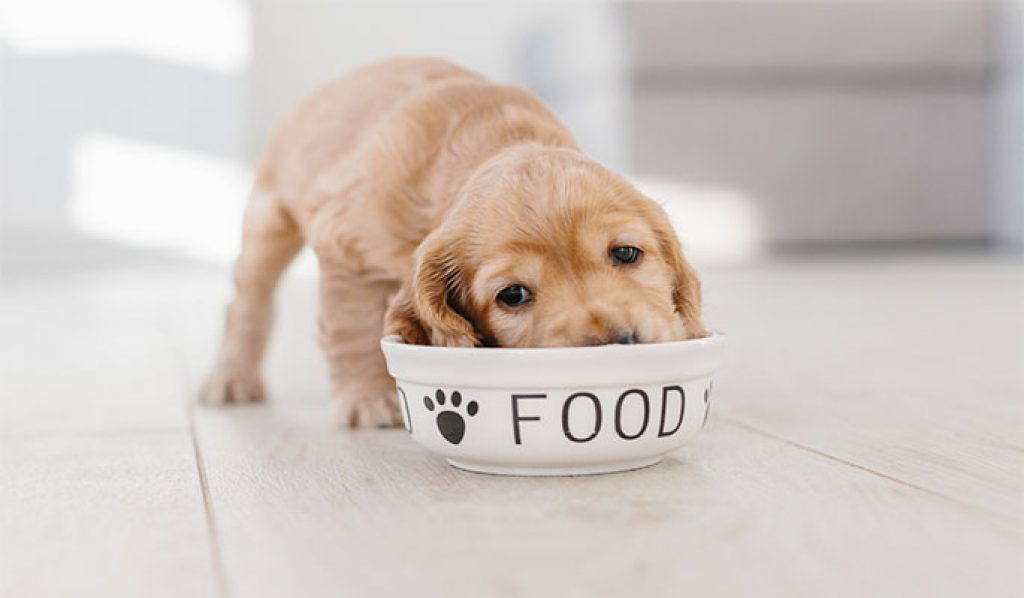What to Feed a Puppy: A Complete Guide (How, What, When, Where)

What to feed a puppy? A new puppy can be a lot, especially figuring out how, what, when, and where they are meant to eat. You can find it all in this guide.
Are you adding a new furry friend to your family?

Whether you’ve recently purchased or adopted, or you’re planning to do so, you’ll want to be totally prepared to care for your new pet. And, there’s nothing more important to your dog’s health than it’s diet!
If you’re not exactly sure what to feed a puppy, this article is for you. We’ll break down all the basics of good diet and nutrition, plus throw in some top tips for feeding time.
Keep reading for all the details!
Read More:
- 3 Tricks for Switching Dog Food Effectively Without Making Your Dog Sick
- A Simple Guide To Make Your Dog Switch To A Raw Diet
- How to Teach Your Dog to Come
- 5 Healthy Reasons to Switch to Grain-free Dog Food
- Best Dog Food Review 2022 (Large Breed & Small Breed)
Weaning
Your puppy should stay with its mother for at least the first six to eight weeks of its life. This will allow for plenty of nursing time, helping your new fur baby learn valuable social skills and gain essential nutrition. Natural nursing provides the most nutrients and delivers vital antibodies to help protect a young pup from illness and disease.
In many cases, your puppy will have been totally weaned before becoming available for sale or adoption. If not, you’ll need to gradually introduce solid puppy food over the course of two to three weeks.
This process can begin as early as four weeks of age, with a blended gruel made from the puppy food and a milk replacement product. You can gradually add more solid food to the mix over the next few weeks, gradually adapting your pet to its new diet. This slow and steady approach helps to avoid an upset stomach and should be completed by eight weeks in age.
How Often to Feed a Puppy
Your puppy’s feeding schedule will change dramatically as it grows. But, during the first few weeks of life, your new pet will need to eat at least three to four times each day.
Smaller meals are easier for a puppy to digest, and will help keep its energy levels constant during the day, rather than peaking and crashing. Carefully scheduled meals can also help with house-training, establishing set times for your pet to eat, and relieve itself outdoors.
At around six months of age, you can make the switch to twice-a-day feeding. Though, for some larger breeds, a routine of smaller and more frequent meals can be key to preventing gastric dilatation-volvulus, commonly known as bloat.
What to Feed a Puppy
Puppies have higher caloric and nutritional needs than adult dogs. So, the food you select should contain plenty of protein, calcium, and calories.
Select a high-quality puppy food that lists meat as its first ingredient. And, if possible, avoid products that contain a high percentage of corn or meat by-products, as these can negatively impact your puppy’s health, offering empty calories and less nutrition.
Avoid feeding your dog puppy food on into adulthood, as this can lead to obesity and other health issues. Most owners make the switch at around six months of age. But, you may need to start making this change earlier of your pup starts to put on too much weight.
Making the Switch to Adult Food
Once your puppy begins to mature, it’s time to make the switch to adult food.
Just like weaning, you’ll want to do this slowly, over the course of several weeks. Gradually mix increasing amounts of adult food into your pup’s meals, eventually transitioning entirely away from the puppy food. Stretching this process out, rather than making a drastic switch, is better for your dog’s digestion, and can help prevent an upset stomach.
When choosing an adult dog food, you’ll want to keep your pet’s activity and exercise levels in mind. You’ll still want a product made mostly from meat. But, a blend with far fewer calories is best, especially if your doggo spends most of its time indoors.
Keep Size in Mind
Generally speaking, the smaller the dog, the faster it will reach maturity.
Smaller breeds (up to 30 pounds) will reach full maturity at around ten to twelve months of age. But, this change can happen even sooner in some toy breeds.
Medium-sized dogs (up to 80 pounds) will develop more slowly, fully maturing at twelve to sixteen months. This period can vary greatly, especially among mixed-breed dogs.
Large breeds (over 80 pounds) can take two full years to reach maturity. This is especially evident among supersized dogs like Great Danes and Great Pyrenees. Talk about a puppy phase!
Trusted Products
When it comes to feeding puppies, choosing the right product is essential.
You can begin by asking your veterinarian for a few recommendations based on your new pet’s breed and general health. Keep in mind that any change in diet should be done slowly, especially if your dog has become used to low-quality food. Sudden switches in your fur baby’s diet can cause serious digestive issues!
Before making a final food selection, read a few online reviews from people with similar pets to your own. And start by purchasing a small amount to make sure that your dog enjoys its new diet. Believe it or not, there are some pretty picky eaters in the dog world!
If you’re planning to purchase pet food, products, or accessories online, you should always shop with a trusted retailer. Kleinmetall has been offering high-quality dog supplies for over 45 years, featuring German engineering and cutting edge design. Their transport systems and car accessories are perfect for active pets and people on the go!
Feeding Your New Furry Friend
Now that you know how, when, and what to feed a puppy, you’re ready to start caring for your new furbaby. And, you’ll have peace of mind knowing that you’re doing all that you can to help them live a long, healthy life. Just remember, setting a routine and sticking to it is a key factor when it comes to feeding your new companion.
Did you enjoy this article? If so, don’t miss out on the rest of our content. Our blog posts are packed with helpful tips, advice, and how-to guides on dog care, training, and different breeds.


